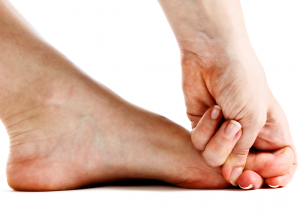
Hallux Rigidus
Hallux rigidus is the medical name for a common type of arthritis that occurs at the base of the big toe. Arthritis is a degenerative disease that causes pain and stiffness in the joints, and hallux rigidus causes these symptoms in the big toe (called the first metatarsophalangeal joint).
Hallux rigidus — also called stiff big toe — is one of the most common forms of arthritis that affects the feet. It affects both older patients as well as adolescents.
Symptoms of Hallux Rigidus
The first and most noticeable symptom of hallux rigidus is pain around the base of the big toe. Most people seek medical attention when the pain becomes so frequent and strong, it’s difficult to walk, run and jump.
Other common symptoms of hallux rigidus include toe stiffness, difficulty moving and bending the big toe, swelling at the base of the toe, an abnormal toe shape, frequent calluses near the big toe, and bone spurs (bony lumps) that form as your body’s way to minimize toe movement and therefore minimize pain.
One way some people determine whether or not their toe pain is caused by hallux rigidus or another type of foot ailment is by trying stiff-soled shoes. Usually, firm shoe soles that help prevent motion at the base of the big toe can help decrease symptoms.
Hallux Rigidus Causes
As with other types of arthritis, a direct cause of the disease remains unknown. However, most doctors believe it is caused by excessive wear and tear of the first metatarsophalangeal joint either from certain types of footwear or from certain daily activities that frequently stress the big toe. Particularly active people (professional athletes, dancers, etc.) are especially prone to developing hallux rigidus.
Some cases of hallux rigidus are caused by previous trauma to the foot or trauma to the joint (turf toe). In fact, many people who develop hallux rigidus suffered a foot injury in high school during sports, dance or other such types of activities. Sometimes hallux rigidus runs in families, meaning a person could be genetically susceptible to developing the arthritis.
Treatment of Hallux Rigidus
Arthritis is not curable, but there are several ways to treat the symptoms of hallux rigidus. The first options your doctor will likely recommend include:
- Wearing stiff soled shoes: Any stiff or firm-soled shoes that help prevent the big toe from bending can help eliminate hallux rigidus pain. You can look for shoes that have less flexible soles or you can get a custom made shoe insert that helps reduce the movement of the toe.
- Wearing a curved rocker bottom insole: A rocker-bottom is a curved insole that can be added to the inside of your existing shoes. The curved shape allows the foot to more smoothly transition from heel to toe while walking, similar to how a curved shape allows a chair to rock. A rocker-bottom insole also reduces the movement of the arthritic toe and thus helps minimize symptoms.
- Anti-inflammatory medications or cortisol: Most types of arthritis respond well to anti-inflammatory drugs that help decrease joint pain and swelling. Some patients also opt for an injection of cortisone when over-the-counter medications aren’t enough on their own.
If the above options don’t work, you may be a candidate for cheilectomy surgery or arthrodesis (joint fusion). A cheilectomy is an operation that aims to remove bone spurs that often grow in response to hallux rigidus and is recommended for patients whose joint motion has been affected by the bony lumps. An arthrodesis fuses the joints together to eliminate joint pain but comes with the side effect of permanent toe stiffness.
Notice concerning medical entries:
Articles having medical content shall serve exclusively for the purpose of general information. Such articles are not suitable for any (self-) diagnosis and treatment of individual illnesses and medical indications. In particular, they cannot substitute for the examination, advice, or treatment by a licensed physician or pharmacist. No replies to any individual questions shall be effected through the articles.






